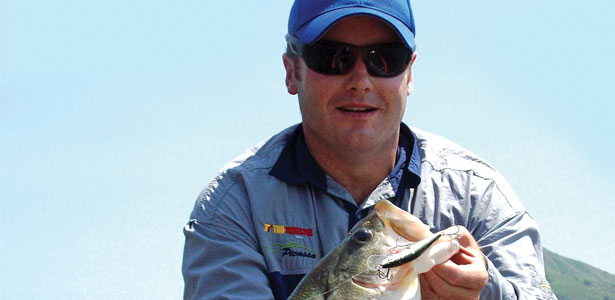
The Chegutu Classic at Mazvikadei Dam in Zimbabwe was the venue for one of the first bass tournaments I ever fished. Having spent many a day fishing this dam in years past, social fishing and armed with my dad as my fishing partner – we were in high spirits and confident going into the event.
Having caught a few fish earlier that morning in various other spots on the dam, we decided to make a run to the river region to search for some larger fish. Choosing to fish the left hand bank at the start of the river section we cruised the bank with the mid morning sun on our backs. We were targeting fish in fairly clear water with weightless baits, making long casts to visible shoreline cover and vegetation. We glanced down into the water to see two LARGE bass and one small bass occupying two nests within 30cm of each other. To say we were both short of breathe and speech for the next few minutes is a minor understatement. Without too much drastic movement, we continued over the nests and fish trying not to get too flustered by the amazing sight we had just seen. Once we felt we were a long casting distance away from the area, we both took turns at firing our baits back towards the nest, waiting in great anticipation for the famous ‘flick’ of the line that comes with a bite. The bite however never came even though we persisted from a safe ‘unseen’ distance for a good 45 minutes, but with no joy.
Totally frustrated we cruised over the area to see if the fish had moved, only to find them still sitting on the nests. Even more confused we decided to ‘rest’ the spot, cranked the main engine and headed out of the river to try another area. Returning to the same river section two hours later we were met with slightly improved conditions - a slight ripple on the water from the breeze and patchy overcast weather covering the bank. We stopped a good 100 meters from the ‘area’ and made our way to the sweet spot from a different angle to what we had fished originally. We downsized our weightless baits from 51/2 inches to 4 inches and my dad cast to the right and my cast settled to the left. He reared back and almost on time, we were both fighting fish. My ‘little’ fish (2.7lbs) was rushed to the boat and swung aboard while my dad battled the larger bass. The beast, a 9.4lb hen fish did not take long to get to the boat and was scooped into the net on its first pass and rested on the bottom of the boat.
Being one of our first tournaments – we went NUTS with joy – which also informed EVERY other angler in the river section of our recent capture. Immediately, we had boats moving in on our little area. Dad was taking care of his prize fish and preparing it for the livewell, while I shakily re-rigged my bait, re-positioned the boat and fired another cast into the general area from where the two fish had just come from. Before time had lapsed for me to turn around to give my dad grief for ‘jamming’ the big fish, my line tightened up and I set the hook on the second big fish that we had earlier spotted sitting on the nests. She wrestled briefly in the shallows but was landed quickly and pushed the scales to 8.8lbs. We knew we had taken the two fish we had seen on the nests earlier and decided it was best to make our way back to the weigh station to officially weigh and release the two hen fish as soon as possible.
We did not win the tournament, but these two spawning fish moved our team 38 places up the leader board to a respectable 4th place finish. Fifteen years on and much research and many on the water tests since, have never put me in such a sight fishing position on spawning fish again. Maybe one day…
Sight Fishing
Sight fishing and targeting spawning bass can be enjoyable when searching for personal bests and kicker fish to increase livewell limits during competitions – but anglers should seldom rely on this technique as a solid pattern, as pre-spawn and post-spawn fish will in most cases be a little more predictable and often easier to catch.
A few days of consistent water temperatures of 60°F will send hen fish from their staging positions up to the shallows to prepare for the annual spawn. Not all fish in our waters spawn at the same time and depending on water temperatures throughout the dam, pre-spawn, spawn and post - spawn fish are usually caught on the same piece of water at the same time. When searching for the first wave of spawning hen fish, start off looking for shallow banks on the southwestern side of most of southern African dams, as they receive most daytime sunshine. Bays and coves in the upper regions, further away from the dam wall usually see the first wave of hen fish as the area around the dam wall is deeper and often a few degrees cooler. Let the water temperature be your guide on any piece of water during this period.
Largemouth hen fish usually bed down to spawn when water temperature has been between 62° – 68°F consistently for 3 – 7 days. The moon phase does play a vital role in the spawn period as this is one of the natural keys, along with the constant water temperature that sends hen fish to nest and spawn. Three days before and after the full moon is considered the prime spawn time of moon phase, if conditions are constant and favourable. Saying this, spawning fish can be taken at other times of the moon phase but are not considered the prime times.
Nests usually have a diameter of between 30 – 50cm and are constructed on sparse gravel banks, clay mounds (ant heaps), on top of stumps, large flat shallow rocks and holes in sparse vegetation (if the bottom composition is not too soft). Finding largemouth spawning on banks dominated by sandy bottoms, unless a healthy composition of gravel exists, seldom occurs, except when chasing smallmouth bass. Once a largemouth hen fish has chosen her nest she will lock onto it for the next 2-3 days while she spawns.
During this time, most nests have what is known as a ‘sweet spot’. This small section within the nest is named because of the response it usually creates on a spawning fish. This ‘sweet spot’ is often a 5-10cm section of the nest that can change in position each time a hen fish uses it. For example a ‘sweet spot’ can be something as small as a golf ball sized rock lying on the side of a clean 50cm nest, or a slightly indented hole in the centre of a small 30cm gravel nest, or anything similar. Sight fishing from a decent distance will enable anglers to determine the ‘sweet spot’ within a few casts to different areas of the nest. The agitated response (moving around the nest with more haste, flapping fins a lot more enthusiastically and lowering itself down to look at your bait on the nest and making small circles around the nest) from the spawning fish will help guide bassers to lock on to the ‘sweet spot’ within the nest and indicate a target area for the angler to focus on. If the hen fish moves off the nest and does not return for a good period of time, or does return but stays a good distance away from the nest – then she will be tough to catch and anglers will most often be better off searching elsewhere or returning another time. If she keeps returning to the nest, she is catchable.
Favoured techniques for targeting spawning fish :
Weightless - 4” Yamamoto Senko; 4” Kamakazee Deep Stixs ; 5” KamakazeeTwitch Shad and 3.5” Finesse Tubes (Cast to spawning banks where fish are believed to be spawning. Fish are taken as the bait sinks or once settled on the nest).
Weedless Wacky Rig – 5.5” Kamakazee Deep Stix (Crawl slowly through nesting areas).
Light Mojo Rig – 4” or 6” Kamakazee Lizards (Lizards during the spawn are especially effective when slowly crawled through the nest).
Light Texas Rig – Netbait Tiny Paca Craw; 4” Zoom Brush Hog; 4.5” Netbait Baby Mad Paca (Worked through the nest at different speeds, according to the reaction of the fish).
Topwater – SPRO Bronzeye Pop Frog (Brighter coloured frogs cause reaction strikes on aggressive spawning fish in shallow vegetation).
Rattletrap – SPRO Aruku Shad Jnr or 75 (This bait enables me to crawl it along a sparse gravel spawning bay when searching for spawning fish. It also excels in irritating spawning fish that are locked onto the nest because of its ability to sit on its nose and not fall over).
Anglers will often have to rotate a number of baits on a spawning fish in order to get the fish to commit to one, or to react out of instinct. When sight fishing, always carry a few brightly coloured plastic baits - these colours help aggravate the bass and also enable you to let a bait rest on the nest while still keeping eye contact with it from a fair distance. This can help the angler determine if a fished has picked up the bait quicker than what would be seen if watching the bait and it was a natural colour which blended in to the surroundings of the nest. Plain white has proved effective for my ‘bright’ sight fishing situations.
Targeting spawning bass is a hotly debated topic among anglers, mainly due to the possible detrimental affect it can have on the bass population on any particular piece of water. This is probably the reason why few are forthcoming with a penned article on such a topic.
Most bass anglers will encounter spawning bass during their bassing life, and with this in mind for this article, my hope is to educate on the good as well as emphasise the negative that can come from neglect of conservation and care for large spawning bass.
* Preston Dale is an ex Zimbabwean national team bass angler and the proprietor of Goya Trading.
NB: Extra care must be taken when spawning fish are caught and kept in a livewell – re-fill livewell water often, aerate livewell more often/constantly, add calming salts (catch’n’release salts) and place frozen/sealed water bottles into the water each time you re-fill the livewell. this all reduces stress to these sensitive spawning fish. At the weigh station – handle the spawning fish as you would any other pregnant being or creature – with care and get her back to the water as soon as possible. These big spawning fish are the future of southern African bassin’, so please make every effort to conserve the large hen fish caught during the spawn season.


 Visit us our
Visit us our